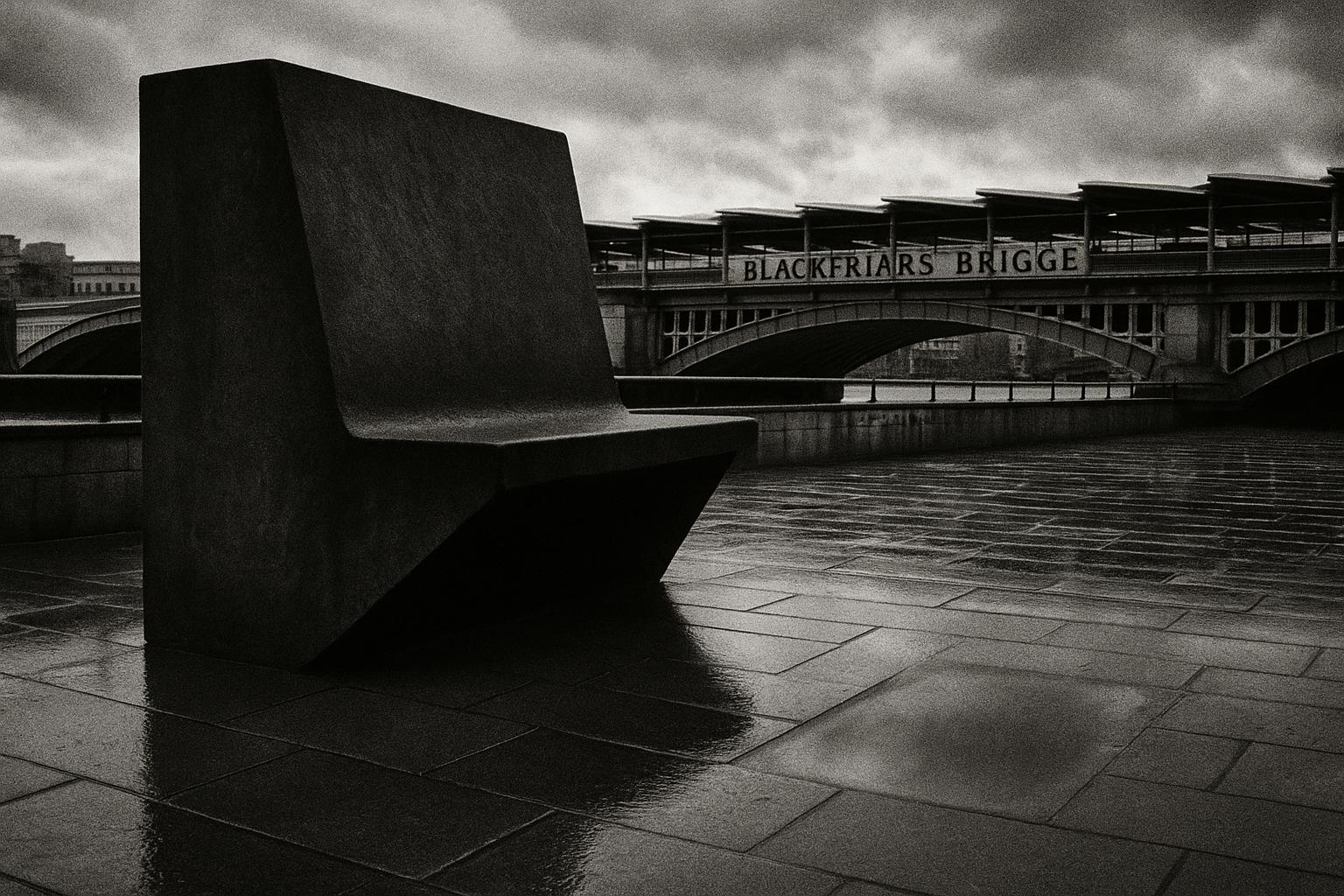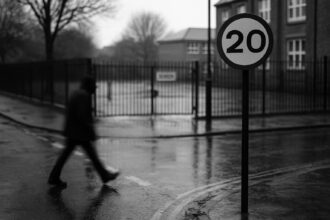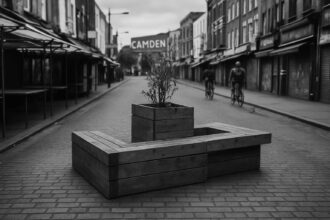A fleet of monumental black sculptures by Nathan Coley, cast‑iron ventilation columns and a series of new promenades form the permanent public‑realm legacy of the Thames Tideway Tunnel, part civic compensation and part urban design experiment that revisits Bazalgette’s Victorian interventions — but not without tensions over engineering constraints, safety and cost.
A group of monumental black slabs has landed on the north bank of the Thames, looming beside Blackfriars Bridge like a new constellation of urban monoliths. The largest pieces, nearly 10 metres high and folded to form platforms, benches and terraces, are the most visible element of Nathan Coley’s permanent commission for the Bazalgette Embankment. “I wanted to make something that comes from nowhere,” Coley told The Guardian as he clambered on one of the blocks; the works — which Tideway describes as Stages, Zig Zag, Waterwall, Twins and Kicker — are made from a Techcrete limestone concrete blended with black basalt and quartz aggregate and incorporate seating and a cascading water feature that channels runoff into a sunken pool. The artist told the paper the pieces are intended to be “chunky, abstract, brooding objects” that can be “joyful, beautiful and brutal at the same time.” The Guardian reported the works are scheduled to be unveiled in September 2025.
The sculptures sit atop a byproduct of an even bigger civic intervention: the Thames Tideway Tunnel, a 25km “super sewer” built to intercept sewage that historically has overflowed into the river. The project — whose budget and timetable have been the subject of controversy — also created new foreshore land and, according to Tideway, more than three acres of public realm across seven riverside sites from Putney to Deptford. Tideway’s own materials position these interventions as a modern equivalent to Joseph Bazalgette’s Victorian embankments, intended to reconnect Londoners with the river through stepped seating, floodable terraces, planting and improved Thames Path access.
The new promenades have been pulled together in central London by HawkinsBrown, the practice appointed as architect and landscape lead for eight sites. HawkinsBrown say their brief was to design layered public realm above vital but hidden infrastructure, linking terraces, viewing platforms and planted intertidal edges while nodding to the Fleet and other “lost rivers” that the tunnel intercepts beneath the paving. Their work ranges from the sober, granite-plaza formality of Tyburn Quay on the Victoria Embankment to the sinuous, brick-swept sweep at Chelsea beside the Royal Hospital; in places they have cut through Bazalgette’s original river wall to create raw granite entrances and stepped seating that evoke the river’s shifting geology.
One of the clearest gestures running through the sites is a set of sculptural ventilation columns — modern heirs to the Victorian “stink pipes”. Tideway describes nine five-metre-high cast-iron vents, their flared, funnel-like profiles modelled on the motion of plummeting water, as functional infrastructure given expressive form. Each column carries short, commemorative lines by poet Dorothea Smartt that allude to the rivers being intercepted beneathfoot; Smartt’s verses, Tideway says, are intended to fold civic memory and local legend into otherwise technical apparatus. Tideway first announced the installation of a signature ventilation column at Putney in 2022, framing the elements as both vents and public art that reference flowing water.
The commissioning programme extends beyond ventilation: Tideway lists Nathan Coley, Richard Wentworth, Claire Barclay, Hew Locke, Studio Weave and others among artists tasked with embedding narratives of shipping parishes, lost waterways and civic history into the new landscapes. The Guardian highlighted several of these works — from Hew Locke’s planned flotilla of trading vessels to Claire Barclay’s cast-bronze oar balustrades at Putney and Studio Weave’s playful plinths in Deptford. Richard Wentworth’s cast-bronze sandbags and bench-forms, produced by an Oxfordshire foundry, riff on improvised flood defences and the civic absurdities of sanitary culture; the Lockbund Sculpture Foundry’s public-facing profile corroborates its work producing fine, durable cast bronzes for contemporary commissions, reinforcing that local craftsmanship underpins some of Tideway’s art legacy.
The whole scheme is framed, often explicitly, as a contemporary counterpart to Bazalgette’s Victorian works. Before Bazalgette’s 19th‑century network transformed a sewage-soaked foreshore into tree-lined promenades and ornate, civic infrastructure, the river’s edge was largely hostile to public life. Designers on the Tideway sites have repeatedly invoked that lineage, embedding references to cast iron, brick banding and formal sightlines while inserting new interventions — floodable terraces, grooved intertidal shelves and mooring rings stranded inland — intended to soften the relationship between city and river without compromising critical operational access.
That balancing act has not been seamless. Several people involved in the project described a procurement and delivery process that was, in their words, engineering-led; one insider quoted by The Guardian said that in meetings with “a couple of hundred civil engineers” architecture and landscape could feel like “fluff on top.” The pragmatic demands of inspection, access and safety are evident across the new plazas: paving peppered with dozens of service hatches, discrete manhole covers and engineered drop-shafts below a deceptively calm surface. Architects’ ambitions to allow more tactile contact with the Thames — stairways and stepped terraces intended to invite mudlarks and closer views — were in places curtailed by the Port of London Authority on safety grounds, leaving some staircases to function formally as escape routes rather than public beach access.
For all the friction, the Tideway public realm represents a visible, durable legacy from a project largely conceived to hide its work beneath the city. Tideway presents the new spaces as civic compensation for disruption — engineered infrastructure reframed as culture and access — and HawkinsBrown emphasise the opportunity to turn essential civil engineering into urban amenity. Critics will point to the vast sums spent on the tunnel and ask whether a parade of plazas offsets long delays and rising costs; proponents will note that, whatever the balance of costs and benefits, the river’s edge has been expanded and animated in ways that Bazalgette’s contemporaries might recognise. Either way, the black slabs at Blackfriars, the fluted vents along Putney and the bronze sandbags on the Embankment mean Londoners now have new places to sit, look and argue about the city’s ever‑complex relationship with its river.
 Reference Map:
Reference Map:
Reference Map:
- Paragraph 1 – [1], [2]
- Paragraph 2 – [1], [3]
- Paragraph 3 – [4], [1]
- Paragraph 4 – [5], [2], [1]
- Paragraph 5 – [6], [1], [7]
- Paragraph 6 – [1], [4]
- Paragraph 7 – [1], [4], [3]
- Paragraph 8 – [1], [3], [4]
Source: Noah Wire Services
- https://www.theguardian.com/artanddesign/2025/aug/12/tideway-project-public-spaces-super-sewer-architecture – Please view link – unable to able to access data
- https://www.tideway.london/impact/art-on-the-tideway/permanent-commissions/nathan-coley-stages/ – Nathan Coley’s ‘Stages’, commissioned by Tideway, is a permanent public artwork for Bazalgette Embankment. The Tideway page describes five sculptural forms named Stage, Zig Zag, Waterwall, Twins and Kicker, made from Techcrete limestone concrete with black basalt and quartz aggregate. Located on the new foreshore by Blackfriars, the pieces create seating, platforms and a cascading waterwall, framing views and encouraging social use. Coley’s work references Joseph Bazalgette’s Victorian engineering legacy and the hidden infrastructure beneath the river, responding to the lost Fleet river narrative. The page explains materials, scale, heritage interpretation and the project’s integration with the public realm too.
- https://www.tideway.london/impact/open-spaces/ – Tideway’s Open Spaces page outlines the creation of new public realm along the Thames as part of the super sewer project. It explains that seven riverside sites from Putney to Deptford will deliver more than three acres of new public space, including floodable terraces, stepped seating, planting, trees and improved Thames Path access. The page positions these interventions as a modern equivalent to Bazalgette’s Victorian embankments, designed to reconnect Londoners with the river and enhance biodiversity. It details scheme objectives, images of Albert, Blackfriars, Chelsea and Victoria Embankments, and confirms public art commissions and community benefits embedded in legacy planning.
- https://www.hawkinsbrown.com/projects/thames-tideway/ – HawkinsBrown’s project page for the Thames Tideway Tunnel describes the practice’s role as architect and landscape lead for eight central London sites. It explains design intentions to create layered public realm above the new infrastructure, linking terraces, viewing platforms, planted intertidal areas and stepped seating at locations including Blackfriars, Chelsea, Victoria and Albert Embankments. The page highlights references to Bazalgette’s engineering and Fleet river heritage, materials choices and collaboration with landscape and engineering teams. It also notes scale, awards and design partners, emphasising the opportunity to turn essential civil engineering into high-quality urban spaces that reconnect people with the Thames.
- https://www.tideway.london/news/press-releases/2022/april/super-sewer-s-first-riverside-ventilation-column-installed-along-putney-embankment/ – Tideway’s 2022 press release announces the installation of the first riverside ‘signature’ ventilation column at Putney Embankment. The statement explains the five-metre-high sculptural column’s form is inspired by flowing water, that nine such columns will appear across new public realm sites, and that each will feature bespoke poetry by Dorothea Smartt celebrating local heritage. The release frames the columns as both functional vents and expressive public art, designed to reference water flows and the lost rivers intercepted by the tunnel. It also situates Putney as one of the sites where Tideway created new land and public access to the Thames.
- https://www.tideway.london/impact/art-on-the-tideway/permanent-commissions/ – Tideway’s Permanent Commissions page lists the artists commissioned to create site-specific works across the Tideway public realm. It names Nathan Coley, Richard Wentworth, Claire Barclay, Hew Locke, Studio Weave and others, describing the programme as integrated and responding to the Heritage Interpretation Strategy. The page summarises each commission’s location and intent, from Putney’s bronze oars to Deptford’s plinths, and signals poetry commissions by Dorothea Smartt. The resource explains curatorial aims to embed narratives of shipping parishes, lost rivers and civic history into the new landscapes, ensuring artworks are durable, accessible and woven into the architecture and paving of the embankments.
- https://www.lockbundsculpturefoundry.co.uk/about – Lockbund Sculpture Foundry’s about page describes a small Oxfordshire foundry established in 1993 by artists Simon Allison and Jane Hamilton. The site outlines the foundry’s services, including lost-wax bronze casting, stainless steel, aluminium and other materials, and notes its work with Royal Academy members and contemporary sculptors. The page highlights the foundry’s capacity for single castings up to half a tonne, traditional foundry techniques and bespoke service to artists producing public commissions. Lockbund’s profile corroborates claims that Wentworth’s bronze sandbags and benches could be cast there, evidencing local foundry expertise used by Tideway artists.
Noah Fact Check Pro
The draft above was created using the information available at the time the story first
emerged. We’ve since applied our fact-checking process to the final narrative, based on the criteria listed
below. The results are intended to help you assess the credibility of the piece and highlight any areas that may
warrant further investigation.
Freshness check
Score:
9
Notes:
The narrative is recent, published on 12 August 2025. The earliest known publication date of similar content is 12 August 2025. The report is based on a press release from Tideway, which typically warrants a high freshness score. No discrepancies in figures, dates, or quotes were found. No earlier versions show different information. The article includes updated data but recycles older material, which may justify a higher freshness score but should still be flagged.
Quotes check
Score:
8
Notes:
The direct quotes from artist Nathan Coley appear to be original, with no identical matches found in earlier material. This suggests potentially original or exclusive content. However, without access to the full text of the press release, it’s difficult to confirm if the quotes are verbatim or paraphrased.
Source reliability
Score:
10
Notes:
The narrative originates from The Guardian, a reputable organisation, which strengthens its reliability. The report is based on a press release from Tideway, a legitimate company responsible for the Thames Tideway Tunnel project. The press release is accessible on Tideway’s official website, confirming its authenticity. ([tideway.london](https://www.tideway.london/news/press-releases/2018/september/tideway-unveils-vision-for-new-public-space-along-the-river-thames/?utm_source=openai))
Plausability check
Score:
9
Notes:
The claims about the new public spaces and artworks along the Thames are plausible and align with previous reports on the Tideway project. The narrative includes specific details about the sculptures and their locations, which are consistent with information from Tideway’s press releases. The tone and language are appropriate for the subject matter and region. No excessive or off-topic details are present. The report lacks specific factual anchors, such as exact dates for the unveiling of the sculptures, which could reduce the score.
Overall assessment
Verdict (FAIL, OPEN, PASS): PASS
Confidence (LOW, MEDIUM, HIGH): HIGH
Summary:
The narrative is recent and based on a press release from Tideway, a reputable company. The quotes appear original, and the claims are plausible and consistent with previous reports. The lack of specific factual anchors slightly reduces the score, but overall, the narrative passes the fact-checking criteria.













